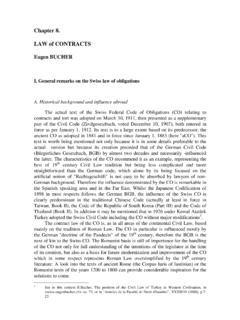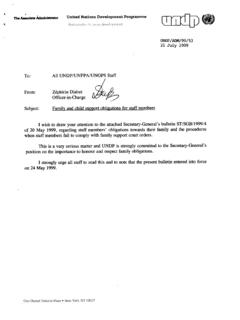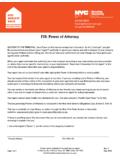Transcription of Accounting for Conditional Asset Retirement Obligations
1 July 2005 FASB Interpretation No. 47 Accounting for Conditional Asset Retirement ObligationsAn Industry White PaperPage 1 FASB Interpretation No. 47 Accounting for Conditional Asset Retirement Obligations An Industry White Paper 2 Reasons for an Interpretation .. 3 Sufficient Information .. 3 Change in the Way Disposal is Viewed .. 5 Date of Obligating Event .. 6 Indefinite 7 Materiality .. 9 Decision Tree .. 9 Specific Property Considerations .. 13 Mass Assets, Electric and Gas .. 13 Minor Asbestos, PCBs, and Other Contaminants .. 21 Rights-of-Way and Franchises ..25 General Hydro Overall Recommendation ..30 Effective Date .. 31 FIN 47, Accounting for Conditional AROs An Industry White Paper Page 2 Introduction This Interpretation clarifies that the term Conditional Asset Retirement obligation as used in FASB Statement No. 143, Accounting for Asset Retirement Obligations , refers to a legal obligation to perform the Asset Retirement activity in which the timing and (or) method of settlement are Conditional on a future event that may or may not be within the control of the entity.
2 The obligation to perform the Asset Retirement activity is unconditional even though uncertainty exists about the timing and (or) method of settlement. Thus, the timing and (or) method of settlement may be Conditional on a future event. This white paper has been written with an eye toward the Electric and Gas utility business. It is intended to assist one in doing the investigation and review necessary to properly recognize and disclose any new Asset Retirement Obligations resulting from the adoption of this Interpretation. Each company will need to work through their particular issues and review all assumptions with their legal staff to assure proper representation of this topic. At first glance, this Interpretation can appear overwhelming. But one needs to approach this in a thoughtful and reasonable manner that represents the intent and purpose of the Interpretation without getting so lost in the details that the Accounting becomes impossible to maintain within a cost effective manner.
3 Without careful thought to the intent and the process to achieve it, the Accounting for this Interpretation may not be manageable as the issue moves throughout time. FASB Statement No. 143, Accounting for Asset Retirement Obligations provides a complex process for determining recognition criteria, measurement procedures, and Accounting and disclosure requirements for the financial implications of an obligation related to the future Retirement of existing property. Because FIN 47 represents clarification of a limited, but important, concept within the broad scope of Accounting for Asset Retirement Obligations , this document is limited to discussing compliance within this new interpretation. It is beyond the scope of this document to attempt to provide a comprehensive discussion of all the provisions of FASB Statement No. 143. Another white paper was prepared by EEI and AGA shortly after SFAS 143 was issued.
4 This white paper is supplemental to that earlier one. The following terms and acronyms are used throughout this document. Term or Acronym Description ARC Asset Retirement Cost (Plant Asset ) ARO Asset Retirement Obligations FERC Order 631 Accounting , Financial Reporting, and Rate Filing Docket No. RM02-7-000, Requirements for Asset Retirement Obligations FERC Order 552 Revision to Uniform Systems of Accounts to Account for Allowances under the Clean Air Act Amendments of 1990 and Regulatory-Created Assets and Liabilities and to Form Nos. 1, 1-F, 2 and 2-A FIN 47 or Interpretation FASB Interpretation No. 47, Accounting for FIN 47, Accounting for Conditional AROs An Industry White Paper Page 3 Term or Acronym Description Conditional Asset Retirement Obligations FSP FASB Statement of Position SAB 99 SEC Staff Accounting Bulletin No. 99, Materiality SFAS 71 FASB Statement No. 71, Accounting for the Effects of Certain Types of Regulation SFAS 143 FASB Statement No.
5 143, Accounting for Asset Retirement Obligations Reasons for an Interpretation Diverse Accounting practices have been developed with respect to the timing of liability recognition for legal Obligations associated with the Retirement of a tangible long-lived Asset when the timing and (or) method of settlement of the obligation are Conditional on a future event. For example, some entities have recognized the fair value of the obligation prior to the Retirement of the Asset with the uncertainty about the timing and (or) method of settlement incorporated into the liability s fair value. Other entities, however, have recognized the fair value of the obligation only when it is probable the Asset will be retired as of a specified date using a specified method or when the Asset is actually retired. The Interpretation clarifies that an entity is required to recognize a liability for the fair value of a Conditional ARO when incurred if the liability s fair value can be reasonably estimated.
6 The Interpretation clarifies when an entity would have sufficient information to reasonably estimate the fair value of the ARO. This clarification should improve the relevance, reliability, and comparability of the amounts recognized in the financial statements. The FASB believes application of the Interpretation will result in a more consistent recognition of liabilities relating to AROs, in more information about expected future cash outflows associated with those Obligations , and in more information about investments in long-lived assets because additional Asset Retirement costs will be recognized as part of the carrying amounts of the assets. At the January 26, 2005 meeting, the FASB addressed a request to reconsider the entire concept of recording AROs (see FASB Board minutes at ). This discussion provides significant insight to the FASB s expectations and considerable support for the role of management s judgment and reasonableness in the recognition of AROs.
7 In summary, the FASB essentially establishes what disclosure is expected whenever there is an ARO while also narrowing the circumstances in which the measurement could be avoided. Sufficient Information In SFAS 143, the term Retirement is defined as the other-than-temporary removal of a long-lived Asset from service. The term Retirement encompasses sale, abandonment, recycling, or disposal in some other manner. The term does not encompass the temporary idling of a long-lived Asset . FIN 47, Accounting for Conditional AROs An Industry White Paper Page 4 If an entity has sufficient information to reasonably estimate the fair value of an Asset Retirement obligation, it must recognize a liability at the time the liability is incurred. An Asset Retirement obligation would be reasonably estimable if (a) it is evident that the fair value of the obligation is embodied in the acquisition price of the Asset , (b) an active market exists for the transfer of the obligation, or (c) sufficient information exists to apply an expected present value technique.
8 This is from paragraph 4 of the Interpretation. The Interpretation states that when the method of settlement and settlement date have been specified by others such as in a law, regulation or contract, the entity has sufficient information to apply an expected present value technique. Therefore the ARO would be reasonably estimable and a liability must be recorded. The only uncertainty in these situations is whether performance will be required. From paragraph 5a, uncertainty about whether performance will be required does not defer the recognition of an Asset Retirement obligation because a legal obligation to stand ready to perform the Retirement activities still exists , and that uncertainty does not prevent the determination of a reasonable estimate of fair value. There are two possible outcomes in situations in which the only uncertainty is whether performance will be required the entity will be required to perform or the entity will not be required to perform.
9 If there is no information about which outcome is more probable, paragraph A23 of SFAS 143 requires 50 percent likelihood for each outcome to be used until additional information is available. In certain cases, determining the settlement date for the obligation that has been specified by others is a matter of judgment that depends on the relevant facts and circumstances. In situations where the date and method of settlement are not specified by others, if information is available to reasonably estimate (1) the settlement date or the range of potential settlement dates, (2) the method of settlement or potential methods of settlement and (3) the probabilities associated with the potential settlement dates and potential methods of settlement, the FASB believes sufficient information is present to apply an expected present value technique.
10 Therefore, the ARO would be reasonably estimable and a liability must be recorded. Information that is derived from an entity s past practice, industry practice, and management s intent can provide a basis for estimating the potential methods of settlement. Entities must take into account only the methods of settling the obligation that are currently available to the entity. The ability of an entity to indefinitely defer settlement of an ARO does not relieve the entity of the obligation. Implicit in this conclusion is the belief that no tangible Asset will last forever (except land) and, accordingly, the Asset Retirement activities will eventually be performed. Furthermore, the ability of an entity to sell the Asset prior to its disposal does not relieve the entity of its present duty or responsibility to settle the obligation. The sale would cause the buyer to assume the obligation, in turn affecting the sales price.






